| |
|
Wednesday, April 9 Jacob Goldberg Lecture: Iran versus Israel
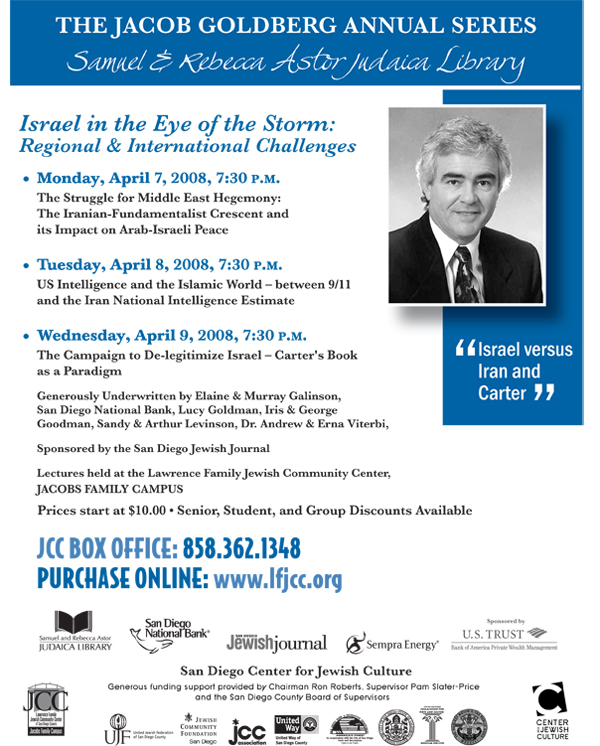
Friday-Sunday, April 11-13 Mountain Chai~Big Boys Getaway
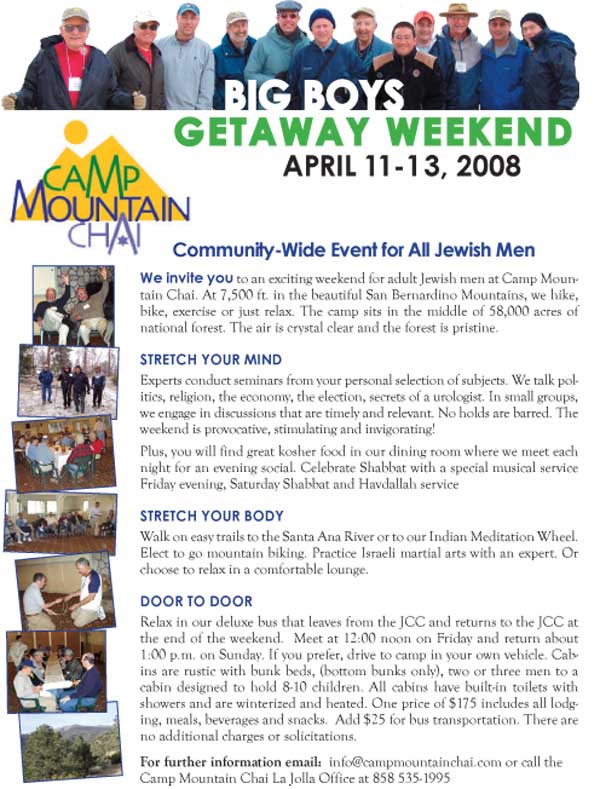
SUNDAY, APRIL 13 Beth Israel~Israel at 60 photo exhibit

Sunday, April 20 Beth Am~Second Night Seder
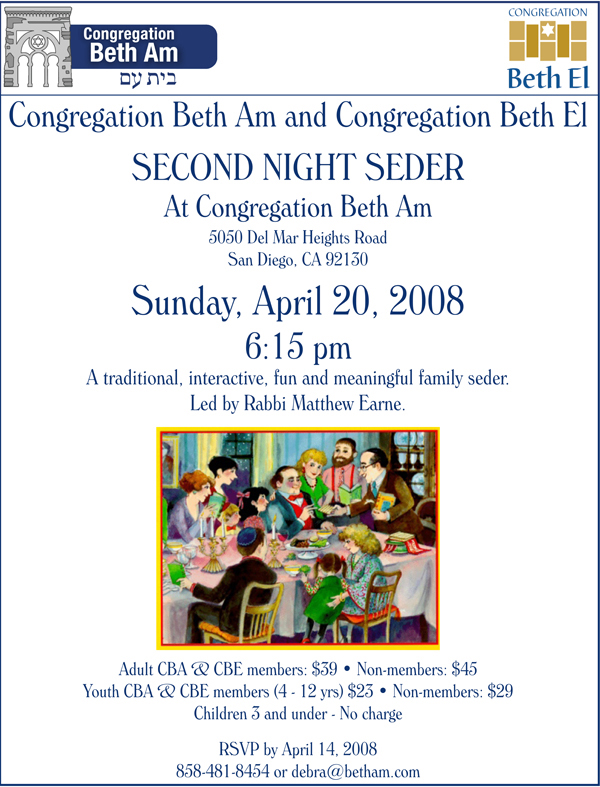
Wednesday, May 28 JFS~Ellen Saks lecture on mental illness
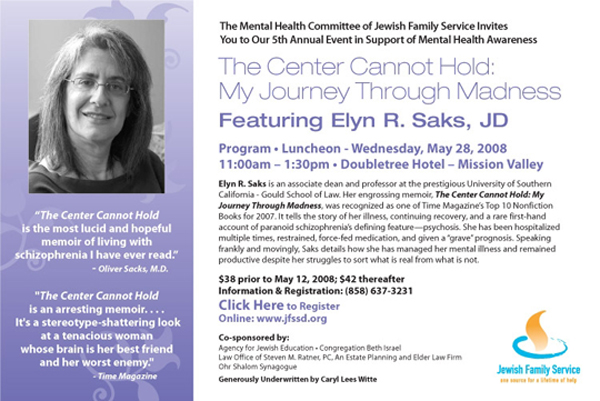

Schools and Colleges:
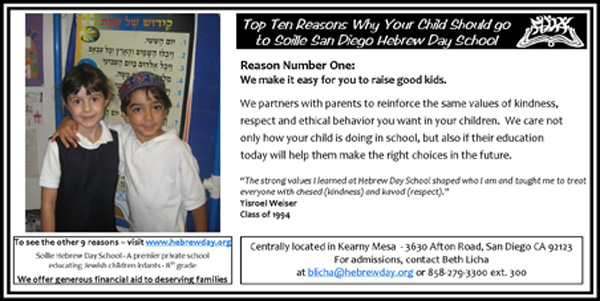



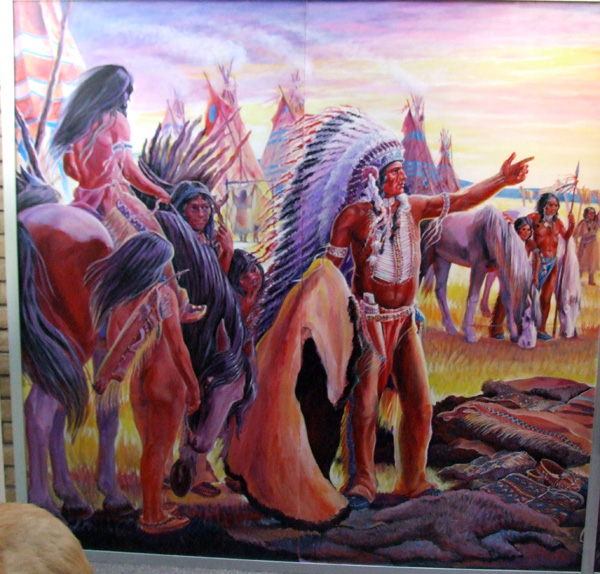
THE JEWISH CITIZEN'A Jewish Story Everywhere'
Searching for the 'Lost Tribes of Israel' at the Heritage of the Americas Museum
By Donald H. Harrison
 RANCHO SAN DIEGO, California—There are several theories about the origin of the Native Americans. The Heritage of the Americas Museum here subscribes to the most commonly accepted theory among academics, for which there is a considerable body of evidence, that Native Americans may have originated many millennia ago in Asia. The theory holds that they crossed a land bridge in the vicinity of the Bering Strait and then over the centuries were diffused throughout the Americas. In keeping with this theory, collector Bernard “Bud” Lueck, the late founder of this museum, devoted a considerable portion of his museum to artifacts from China. RANCHO SAN DIEGO, California—There are several theories about the origin of the Native Americans. The Heritage of the Americas Museum here subscribes to the most commonly accepted theory among academics, for which there is a considerable body of evidence, that Native Americans may have originated many millennia ago in Asia. The theory holds that they crossed a land bridge in the vicinity of the Bering Strait and then over the centuries were diffused throughout the Americas. In keeping with this theory, collector Bernard “Bud” Lueck, the late founder of this museum, devoted a considerable portion of his museum to artifacts from China.
However, there are other theories as well, two in particular which, even if they don’t have much academic research to back them up, have a certain sentimental appeal for their advocates. One theory, expressed by some Native Americans, is that they originated right here in the Americas, not somewhere else, and that whatever cultures they developed were wholly indigenous, not influenced by anyone else from somewhere else.
Another theory, which early Christian explorers and settlers in the Americas really embraced, and which held a certain nostalgic attraction for Jews too, was that the Native Americans were descended from the Ten Lost Tribes of Israel, who somehow made it to the New World long before Columbus. This theory was a favorite of the founders of Rhode Island and Pennsylvania, Roger Williams and William Penn, and also had its advocates among colonists for Spain such as Aron Levi de Montzinos, a Marrano who said he heard a group of people living in the mountains of South America reciting the Shema.
The circular-shaped museum on the grounds of Cuyamaca College is divided into four galleries that offer visitors a “journey through time,” according to its director, Kathleen Oatsvaal. Early geologic time is represented in the natural history wing, where one can find meteorites, rock formations, shells, and animals predating human civilization Next comes an archaeology wing, in which one finds such evidence of human life as arrow heads and other implements. Additional cultural artifacts are in the anthropology wing while representations of various Native American cultures can be found in the art wing.
Among the tens of thousands of artifacts are, here and there, displays that might quicken the hearts of the ‘Lost Tribes’ advocates. Among display after display of arrow heads made by indigenous peoples are, for comparison purposes, a Syrian rat-tail spear, and a bronze axe head dated between 2150 and 1750 BCE. This, of course, does not mean that the idea of arrow heads somehow got transported to the Americas from the Middle East—rather, according to Oatsvaal, they are evidence that at a certain point in the cultural evolution of human beings, wherever they might live, implements are needed for killing an animal, chopping a plant, or digging a hole.
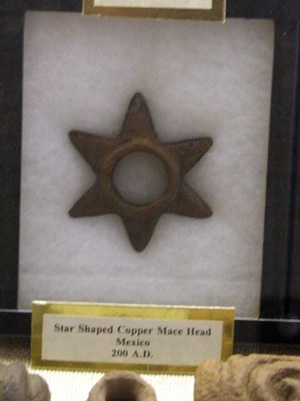 The sentimentalist might also draw hope from a six-pointed “star shaped copper mace head” from Mexico that dates back to approximately 200 CE. But, as anyone who plays Chinese checkers is aware, six-pointed stars are used in ways utterly unrelated to the Star of David. So, there’s really nothing to suggest that this six-pointer in the museum’s Teotihuacan collection curated by Roberto Yeaton is anything other than a coincidental shape. The sentimentalist might also draw hope from a six-pointed “star shaped copper mace head” from Mexico that dates back to approximately 200 CE. But, as anyone who plays Chinese checkers is aware, six-pointed stars are used in ways utterly unrelated to the Star of David. So, there’s really nothing to suggest that this six-pointer in the museum’s Teotihuacan collection curated by Roberto Yeaton is anything other than a coincidental shape.
Although I did not see any examples of this at the museum, the same might also be said about the swastika, which has found expression in Native American cultures as well as in Buddhist symbolism. I remember while visiting Taiwan several years ago, Nancy and I felt uncomfortable upon first seeing a building with a swastika symbol. But we soon came to recognize that in its Buddhist context it was benign, and utterly unrelated to the Nazis.
It’s fun to find analogies between objects—even if those analogies are only in the mind of the beholder.
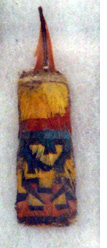 Looking at Chimu feather pendants from Peru, circa 900 to 1200 CE, I was reminded of the mezuzot that some Jews like to wear around their necks. Except for the fact that the delicate pendants were in a display case and were therefore protected from inquisitive hands, I might have been tempted to turn the object over to see whether there was a secret compartment in the back in which someone might slip a piece of sacred writing. Looking at Chimu feather pendants from Peru, circa 900 to 1200 CE, I was reminded of the mezuzot that some Jews like to wear around their necks. Except for the fact that the delicate pendants were in a display case and were therefore protected from inquisitive hands, I might have been tempted to turn the object over to see whether there was a secret compartment in the back in which someone might slip a piece of sacred writing.
Giving in to the Lost Tribe of Israel fantasy, I looked at a Mona Mills painting depicting Cheyenne life, circa 1840, and I found myself staring at the breast plate worn by the chief, and wondering how different it was really from that worn by the High Priest of the Israelites.
And when I saw Phoenician trade beads dating back to 2500 BCE among the artifacts in the museum’s China exhibit, I wondered what other peoples of the Middle East had trade items that were fingered and counted around the world.
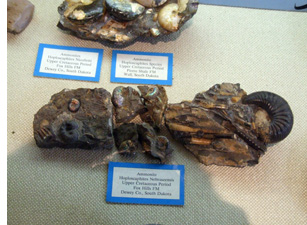 While clearly, the exhibits offered only the most miniscule and fragile threads upon which to hang a Lost Tribe theory of Native Americans, there was indeed ample evidence that Hebrew Scriptures have influenced nomenclature for exhibits in such places as the Heritage of the Americas Museum. While clearly, the exhibits offered only the most miniscule and fragile threads upon which to hang a Lost Tribe theory of Native Americans, there was indeed ample evidence that Hebrew Scriptures have influenced nomenclature for exhibits in such places as the Heritage of the Americas Museum.
In the exhibits one can find Adamite from Mexico, Malachite from an unidentified location, and Ammonite (at right) from Dewey City, South Dakota. Walking through the museum’s desert garden, there are two examples of the Texas variety of the Joshua.

REFLECTIONS
Tales from My Garden: The Third Day...
By Sheila Orysiek
And G-D said: “Let the earth bring forth plants, vegetation that produces seed, fruit trees, each making fruit of its own kind, which has its seed in it, on the earth.” And it was so.
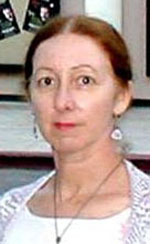 SAN DIEGO—I am watching my garden spring to life not from the deep sleep of the northern latitudes, but from the mild semi-somnolent state which the flora embraces here in the Southwest. Few of my garden plants are deciduous; most simply don’t flower until the longer hours of sunlight awaken them to bloom. In San Diego rose pruning occurs in January, thus by April my two climbing roses, Queen Elizabeth and America standing behind a glorious Peace Rose, are already heavy with buds. SAN DIEGO—I am watching my garden spring to life not from the deep sleep of the northern latitudes, but from the mild semi-somnolent state which the flora embraces here in the Southwest. Few of my garden plants are deciduous; most simply don’t flower until the longer hours of sunlight awaken them to bloom. In San Diego rose pruning occurs in January, thus by April my two climbing roses, Queen Elizabeth and America standing behind a glorious Peace Rose, are already heavy with buds.
Up one side of an arched redwood arbor climbs a pyrocanthus which has red berries left over from the fall, mixing gloriously with the new white blossoms of this spring. On the other side of the arbor is a vigorous blue morning glory; thus red, white and blue patriotically blend together providing berries and nectar for my friends - the birds. However, it is the clothes line on one side of the garden upon which hangs this tale.
This clothes line has a history. Many years ago a huckleberry bush - a huge huckleberry bush - grew and thrived in an empty lot on the other side of my fence. The lot was empty of people, but not empty of life. How the birds loved those huckleberries! They ate them until they were almost comatose with greed. They also ate them when the berries had fermented and the birds could only fly as far as my clothesline and totter tipsily, trying to hang on; some failing, fluttering to the ground, waddling and chirping happily.
My cat was amazed at the sight, but not amazed for too long; this was a once in a life time opportunity for fresh poultry - au vin. I felt this was unfair and so brought the cat in to spend the next few hours watching in despair from the screened patio. How could I be so heartless her eyes asked me? G-D had created this living larder for her - marinated and all.
In addition to the tell-tale signs of spring that one usually - easily - espies, there are other signs - and once again this involves the clothesline. I noticed that the ends of the rope were more frayed then they had been and wondered why. The question was answered when I saw a song sparrow with a yellow wing hovering as best he could, or she - while quickly pulling out the fluffy strands from the rope end. Ah, somewhere (the cat probably knew where) a nest was a building and the new little songsters would be swaddled in soft frayed strands of cotton.
We often look up into the sky when we hear a helicopter or a jet - but much of what takes place up there happens without a sound. A crow or a vulture, so awkward on the ground, so magnificent in the air - soaring, circling, hardly a wing flap - but what is that flutter alongside of them? Something darting, closely following, diving, swooping - it’s a small bird bravely defending its nesting territory. The aerobatics would make any pilot envious. And most of the time, if it is a non-predatory bird, though three times the size of the attacker, the larger bird will leave - happy to be rid of the nuisance. Few birds are more aggressive in defense than the smallest of the hummingbirds.
Watching a flock of migrants assemble, push off into space, and form up a V for long term flight is a sight etched in memory. I was fortunate to see this entirely by chance as I sat reading on a bench in my garden. By lucky happenstance I looked up and saw a reverse tornado of birds swirl upward to attain altitude and then one suddenly broke out of the funnel, pulling the others along behind and into the classic V. And then another and another of the funnels formed and fled. This silent ballet all taking place over a busy city most of whose inhabitants are too busily engaged in human activities to notice.
This brings to mind a book I long ago read….I believe it was One Day in the Life of Ivan Denisovitch by Alexander Solzhenitsyn. Though I may be vague on which of Solzhenitsyn’s books it was, the scene he painted is indelible. He describes a group of prisoners stuck in the Soviet Gulag, deep in the tundra and forests of Siberia. They are clothed in rags, half starved and condemned to work in the salt mines; its winter - winter in Siberia. Getting to work is half the chore - they have to walk several miles through the snow simply to begin their day in the mines.
Some of them are chained. All of them are surrounded by guards who have been brutalized by their task. They too, though better fed, are prisoners of both the police state for which they work and the locale in which they live. As the sun comes its few inches above the horizon, the snow is turned to a sheeted rainbow. And through the forest comes a herd of deer.
Both the guards and the prisoners pause in their trek and watch enthralled by the beauty of the deer - their grace, their place in the forest, and most of all their freedom. The human wretches, both guards and prisoners, stand still for several minuets - forgetting about the day - the years - before them. And then the spell was broken, the guards pull out their weapons, the chains clank and the prisoners resume their march to the salt mines.
With all our self heralded intelligence - who was the smarter here? The animals surely have their fears, their enemies and problems. But those problems are not self made. We alone do that - with that vaunted brain power of ours. We’ve used it to craft chains for ourselves and others. We also craft violins, and play them - but too much of the former and not enough of the latter.
While our would be leaders are busy hurling thunderbolts at one another, while we argue who will get the next big bomb, or what constitutes hate speech (the very idea that we need to contemplate that is in itself instructive), the nature around us is busy collecting strands from the ends of a clothes line to prepare a nest for the life to be.
So, where, you may ask is the Jewish story? It’s everywhere. If your neighbor - even if that neighbor is a bird - flutters to the ground; do something to help. If one is small, one can still bravely defend one’s home. Brutalizing others, brutalizes oneself. G-D’s plan goes on no matter what craziness humans are up to. We need to strive for a day with more violins and violinists and less bomb throwers whether they are metal or verbal. Take time to look up, even when there is no helicopter or jet going by - simply look up - and see G-D’s creation; renewed every spring.
Orysiek is a freelance writer based in San Diego
Click here for easy-to-clip coupon; Product available at Ralphs in La Jolla; The Place in College area
|
THE JEWS DOWN UNDER
Anti-Defamation Commission seeks race ban on hate literature on the web
By Garry Fabian
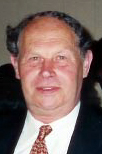 MELBOURNE--A plan to ban websites that peddle race-hatred and defame minorities has been welcomed by communities fighting racism. MELBOURNE--A plan to ban websites that peddle race-hatred and defame minorities has been welcomed by communities fighting racism.
The B’nai B’rith Anti-Defamation Commission (ADC) says extremist racial vilification is occurring on internet sites freely available to Australian consumers, including websites hosted in Australia. This material presents a grave danger to our multicultural society, defaming minorities and inciting racial hatred and violence.
Members of the ADC last week met with Parliamentary Secretary for Multicultural Affairs Laurie Ferguson to discuss their concerns. They cited virulent anti-Semitic material hosted on an Australian website Mission Islam which includes:
- The Protocols of the Elders of Zion, a notorious forgery which alleges an international Jewish conspiracy
- An article on Jews in the US Government which states “There's so many of them it's like a cockroach infestation."
- An article describing “distinctive characteristics of the Jews” such as “they like to spread mischief and corruption” and “they are people of indignity, disobedience and transgression”.
ADC chairman John Searle said his organization had spent several years trying to prevent the dissemination such defamatory material but neither State nor the previous Federal Government had been prepared to act on the issue.
“We have laws banning race hatred and we have laws policing certain kinds of violent and pornographic material on the internet but we have no system to police race hatred on the internet. It’s inconsistent and leads to the abuse of minorities,” he said.
“Government commitment to enhancing multicultural Australia and combating racism requires strong action to combat internet sites engaged in racial vilification.”
State and federal attorneys-general last week commissioned a report on the viability of authorizing the Australian Communications and Media Authority (ACMA) to combat race-hate sites by ordering internet service providers to take them down.
Jewish community deals with child abuse
MELBOURNE—All Jewish schools have been taught techniques for dealing with child abuse within the past six months, according to the Jewish Taskforce Against Family Violence.
Taskforce representative Sheiny New said the organisation ran a forum in December where three different child protective strategies were presented to representatives from all of Melbourne’s Jewish schools.
“We made it very clear that even though we are all Jewish schools, the culture within each school is different and therefore we cannot decide what is right culturally for each individual school,” New said.
A local organisation, Prevent Child Abuse Australia, has called on the taskforce to run an American preventative program called “Stewards of Children”. A representative from the organisation told The AJN the program teaches parents how to prevent their children becoming victims of abuse.
To train members of the Jewish community, Prevent Child Abuse Australia plans to run a two-and-a-half hour session on “Stewards of Children” in the upcoming weeks.
Lorraine Raskin, intake and support services manager at Jewish Care, commended the taskforce and said it had “played an enormous role in raising the profile” of child abuse in the community.
She said a government advertising campaign on domestic abuse had helped raise awareness, but that it may not have filtered through to the ultra-Orthodox community.
“I think that there are pockets of the community that are harder to reach,” Raskin said.
Raskin said Jewish Care had offered assistance to a Jewish school, recently in the spotlight, when some allegations were raised. “We haven’t heard back from them yet, but they have certainly thanked us for the offer.”
Jewish musician receives top honour
MELBOURNE—For Melbourne jazz musician Bob Sedergreen, winning Australia’s most valuable music prize -– the $60,000 Australia Council for the Arts Don Banks Music Award -– couldn’t have come at a better time.
“Three days before the award, three crowns fell out of my mouth,” he said, adding that he intended spending the rest of the money on a worldwide tour and a “second-hand” Volvo.
“It’s an update on my crappy, old Falcon. It’s fairly hard [financially] being a jazz musician professionally over your whole life.”
At a ceremony at Melbourne’s Paris Cat jazz club, Sedergreen was honoured for his “outstanding contribution” to Australian music -– not only as a renowned keyboardist, but as an educator.
He has lectured at the Victorian College of the Arts and the University of Melbourne’s Faculty of Music and has been an artist-in-residence at schools across Victoria.
“Because I’m probably so big, I spread myself over a wide area,” he joked.
But it’s behind the keyboard where Sedergreen has really made a name for himself.
In a glittering 50-year career, he’s recorded more than 20 albums and performed with jazz greats, including Jimmy Witherspoon, Nat Adderley and Dizzy Gillespie.
He regards his involvement with the Australian jazz outfit Art Attack as a “highlight” of his career.
This is the second major award in as many years for Sedergreen. In 2006, he was the first musician to receive the prestigious Ken Myers Medallion for his contribution to the arts.
“I wasn’t expecting anything to follow after that [award]. But this is wonderful,” he said.
Past award recipients of the Don Banks Music Award include composers Richard Meale and Peter Sculthorpe, jazz musician Bernie McGann and conductor Richard Gill.
Jewish representation at summit
CANBERRA—Despite the Rudd Government agreeing to stage a special pre-summit symposium for the Jewish community, there are some 13 Jewish participants in the Australia 2020 summit, which coincides with the first night of Pesach
The Executive Council of Australian Jewry (ECAJ) asked Prime Minister Kevin Rudd for a “please explain” following the government’s decision to schedule the unprecedented event on the first night of Pesach.
After apologising, the government moved to placate Australia’s Jewish community by inviting 50 community members to a symposium, scheduled to be held at Sydney’s Radisson Hotel on the afternoon of April 14.
The discussion points arising from the afternoon symposium are expected to be incorporated into the main summit.
ECAJ president Robert Goot said the prime minister would attend the Jewish event along with Federal Government ministers and the chairpersons of the 10 steering committees.
Despite the government effort to give the Jewish community a voice prior to the holiday, 13 Jewish people have applied and had their nomination to the main summit accepted. That event will take place in Canberra on the weekend of April 19 and 20.
Executive director of the Children’s Cancer Institute Professor Michelle Haber has been invited to discuss a long-term national health strategy.
Helene Teichmann, project convener of Yachad Accelerated Learning Project, which works to advance the education of indigenous students using Israeli techniques, and the University of New South Wales vice-chancellor Professor Fred Hilmer will discuss future directions for the Australian economy.
La Trobe University politics Professor Robert Manne will debate the future of Australian governance and Dr Grant Blashki, who has been trained as a climate-change warrior by former United States vice-president Al Gore, has been placed in the population, sustainability, climate change and water-working group.
Anthony Pratt, chairman of Pratt Industries and Steven Skala, an ABC director, will participate in a discussion on the productivity agenda.
But it will be in the arts arena that the Jewish community will have most prominent voices.
Publisher Louise Adler, playwright Barrie Kosky, broadcaster, author and literary expert Ramona Koval, former ABC director of television Sandra Levy and businessman and philanthropist David Gonski will all participate in discussions on Australia’s creative future.
Israel sparks union spat
SYDNEY--A stoush has developed between the leaders of two of Australia's most prominent unions over their respective stances on Israel.
In a recent statement, the Construction Forestry Mining and Energy Union (CFMEU) accused Paul Howes, the national secretary of the Australian Workers' Union (AWU) of 'using assumption and slander" in a letter to a leading national newspaper, The Australian.
Howes' letter criticised an advertisement placed in The Australian that opposed the Federal Government's motion on Israel's 60th anniversary. The advertisement was endorsed by the CFMEU and Maritime Union of Australia, as well as members of the Independent Australian Jewish Voices and other pro-Palestinian groups.
Howes hit back this week, accusing the CFMEU's New South Wales branch of endorsing an advertisement thAT was "juvenile and offensive" and of taking up a "sexy" cause without analysing the issues.
The union stoush also follows an article by American union boss Stuart Applebaum in New York's Jewish newspaper. The Forward. Applebaum's article criticised the CGMEU and the Maritime Union of Australia for serving up a "diatribe" against Israel by adding their endorsement to the newspaper advertisment.
Andrew Ferguson, secretary of the CFMEU in New South Wales said that his union had supported the Palestinian cause for a long time.
"It is the continuation of a policy position for many decades "Ferguson said.
"I have worked for the union for 30 years and, historically the leadership of the union has adopted a very similar position in relation to this issue.”
In responding to the issues raised by Applebaum, Ferguson said that left-wing organisations typically criticised Israeli policies.
"I think internationally, the people from the communist or socialist left would not be supportive of the current policies of the Israeli Government."
Howes responded by slamming unions that blindly support the Palestinian cause. He argued that as the only country in the Middle East with fully functional and independent trade unions, Israel deserved to support of Australian unions.
"There is much to be critical of Israel in the current conflict, but Israel is a beacon for democracy in the Middle East,” Howes said.
"We think the actions taken by both Fatah and Hamas in oppressing the trade union movement in Palestine is deplorable, and it is the role of trade unionists around the world to support the right for independent trade unions to exists everywhere.”
Howes added that unions were free to make their own policies, but he said he found it difficult to fathom how a union can criticise a country that had a strong tradition of labour rights.
UN bid could hurt Israel
CANBERRA, Australia—On his visit to New York last week, Australian Prime Minister Kevin Rudd made a strong pitch for Australia to win a seat on the UN Security Council in 2013.
But Australia will need to tone down its support for Israel if it hopes to achieve this aim. Shadow minister for Foreign Affairs Andrew Robb has warned the government that to win the necessary votes required to win a seat, it would need to court Arab and African countries.
Robb said this could mean holding back support for Israel because many countries that Rudd would need to convince to vote for Australia do not favour the Jewish State.
"A UN Security Council seat is all about numbers. There are 192 nations and it is not easy to secure sufficient votes, especially for a country like Australia that is down in this part of the world, and is a strong ally of the US, which automatically rules out many votes for us,” he said.
Robb argued that it might not be worth changing our foreign policy and spending an estimated $40 million to open embassies in countries that Australia is attempting to court for votes.
"Is the PM really serious about this, does he intend to reposition Australia on some major foreign issues? The only way I think that any votes would come out of Arab states would be if there was a significant weakening of our support for Israel" Robb concluded.
Bialystock Comes back to life in 21st Century
MELBOURNE— Ophthalmologist Dr Henry Lew is the son of Bialystoker parents. He was born in 1948, the first child born in the Bialystoker Centre in St Kilda, Melbourne, an Italianate mansion set up as a refuge after the war.
Lew’s parents -– Leo (Lonek) and Eugenia (Genia) Lew -– both raised in Bialystok, were not there when the ghetto was liquidated.
They were on holiday when the Nazis invaded and spent the war in Moscow.
Among those who were in Bialystok was a remarkable man, Rafael Rajzner.
Surviving the annihilation of the Bialystok Ghetto and a series of concentration camps, Rajzner was an eyewitness to a litany of crimes committed by the Nazis against the Bialystoker Jews.
He lost his family and all familiar associations with his previous life. But what Rajzner did was write down in notebooks, immediately after the war, what he saw and experienced.
Possessing a remarkable memory, the ability to maintain perspective and a reporter’s facility for recording facts without emotion, Rajzner produced in Yiddish a unique primary source document.
Rajzner arrived in Melbourne in late 1946 and in 1948 had published, by the Bialystoker Centre, The Annihilation of Bialystoker Jewry.
Although having a small print run, the book reached a ready audience. The reason was that Rajzner was able to provide details of family and friends for the small shattered Bialystok community who found their way to Melbourne.
But the book was in Yiddish and this has rendered, until now, its limited reach.
Lew’s father had a copy and when Lew saw the need for Rajzner’s observations to be made more broadly available in English, he set about having it translated.
After deciding not to go with one translator, Lew contacted 50 Yiddish translators worldwide. The response was enthusiastic.
Securing the support of 21 translators immediately, from Australia, Canada and the United States, he sent off the book in 10-page batches.
Several of the translators asked for more pages and, gradually, Rajzner’s recording of what he saw began to emerge in English. In Lew’s words, the translators “gave of their hearts”.
The result is a new and soon to be published book of Rajzner’s original work, retitled by Lew, The Stories Our Parents Found Too Painful to Tell.
The importance of the book in English is immense. Besides Rajzner’s words now being available to not only non-Yiddish speakers but a wider audience than that of 60 years ago, the book has far-reaching significance.
Beyond the immediate relevance to the Jewish community and Bialystokers specifically, a non-Jewish readership also has much to gain.
Lew’s management of the translation of Rajzner’s searing and salutary account goes beyond Jews.
As a contribution to literature dealing with the Holocaust and memory, the book’s significance cannot be underestimated. But The Stories Our parents Found Too Painful to Tell is really a three-layered venture.
There is the reclamation of Rajzner’s observations from the past, the translation of the Yiddish to English and then Lew melding the translations so that there is a single voice speaking from the pages. Reading the book, one soon forgets that this has ever been written in Yiddish.
The transition is seamless. This is all the more remarkable when Lew recounts the way the translations were received.
“When the translations came back, they were often out of sequence so I did not initially get the full impact of what Rajzner had written,” Lew says.
“The translators also got fragments. They perhaps did not get enough to show the graphic nature of Rajzner’s observations.”
What is soon clear is that while Rajzner was not a natural writer, the vividness of his description “immortalises suffering simply.” as Yehoshua Rapaport noted in the original foreword to Rajzner’s 1948 book.
Even so, there is neither judgment nor opinion by Rajzner on the Nazis. This is a work of remarkable clarity and precise integrity. It is because of Rajzner’s avoidance of emotional engagement that the book has enormous residual power.
“He didn’t analyse,” Lew says. “Maybe this was a result of Rajzner’s limited education.
Still, as a recorder and observer he had great skills and a brilliant memory. He also had a remarkable inner strength. A lot of people who went through that didn’t.
“Elie Wiesel, who wrote Night, said that it took him 10 years to recover sufficiently before he could write. But here is someone writing from day one after the war.
“Rajzner became a kind of informer to Jewish people in Melbourne after the war as to what happened to their relatives,” Lew continues.
“He was their source material. There were a lot of Bialystokers who came here in the ’20s and ’30s as it was a bad time for industry in Bialystok, the ’20s.
“Many Bialystokers left and came to Australia. When the book came out in Melbourne, Rajzner got a bit of a following from the people who were already here.
“He was, when working in Biaylstok and setting up the typeface for a newspaper, very blue collar. Probably when he came here, a lot of people in Melbourne, who were better educated than him, may have given him an elevation that he never would have had in Bialystok.
“I don’t think that is why he wrote the book. He wrote it as he had to get it out of his system.”
Given that The Stories Our Parents Found Too Painful to Tell is a remarkably accurate account of what Rajzner as eyewitness saw, he does include many instances of defiance by Jews in Bialystok. These are met with brutality and death.
The book is not a catalogue of atrocities but a recording of the systematic and sustained progressive annihilation of a community.
Still, what endures is the quiet heroism and selfless resistance of the Jewish people. Rajzner is intent on recording it.
He notes for example: “It is important to realise that Jews who went quietly to the gas chambers, seemingly offering no resistance, were also heroes. They acted that way because they were mentally and physically exhausted.”
Earlier still, when he refers to the summary justice meted out on informers by Bialystokers, Rajzner comments: “The Nazis, by their murderous deeds, had degraded our state of mind to the extent that we too had become like wild animals.”
For Lew, the lack of analysis Rajzner gives in a way enhances the book.
“My father said that you have to remember that Rajzner was not an educated man or a scholar, and in a way that makes the book better,” he says.
“He’s an observer and he is telling you what he saw.”

ADVENTURES IN SAN DIEGO HISTORY
Editor's Note: We continue our reprinting from the September 20, 1922 edition of The San Diego Jewish Community News—a benchmark edition that outlined the history of Jewish organizations in San Diego. If you have historical topics about the San Diego Jewish community you would like us to explore, please e-mail your suggestions to editor Don Harrison at sdheritage@cox.net
The Hadassah
By Mrs. Dave Gershon
The San Diego Jewish Community News, September 20, 1922, page 18
In presenting a brief report on the San Diego Chapter of the Hadassah, let me first give a brief outline of the principal object of the organization and what it stands for. In every principal ciy throughout the United States, there has been formed a group or Chapter of this organization, with a total membership of more than fifteen thousand. Of the numerous officers of the Hadassah there are but five throughout (sic) the entire country who are receiving compensation for their services. The principal work alloted (sic) to the members of the various Chapters is the making of simple garments for the orphaned children of Palestine. The organization maintains a large Medical Unit in Palestine where 40,000 orphan children are fed and clothed and given proper medical attention.
The San Diego Chapter has about 80 members who contribute $4,00 per year per capita, $3.00 of which is sent to the organization headquarters in New York for the maintenance of the Medical Unit. We furnish our own materials for the making of garments, the goods being purchased with funds raised in various ways. We have been very fortunate in receiving several donations of yard goods from some of the local stores. The San Diego Chapter was organized but two years ago and since that time has made material progress. We have purchased five second hand sewing machines and shipped to the organization’s headquarters during our first year, 195 finished garments and this past season, we shipped 257 finished garments and also contributed $100.00 toward the maintenance of the Medical Unit and an extra $30,00 for Hospital Sheets. We closed the Season with $100.00 in the treasury.
The Y.M.H.A. is deserving of the highest praise for their generosity in allowing us the use of their Club Rooms for our Meetings, which are held every Wednesday afternoon at 1:30.
Altho (sic) the Hadassah is not a Social Club, we all enjoy the meetings and when convenient, tea and home made cake is served and a social hour is enjoyed at the close of the meeting. There is a work Committee whose chairman provides work, either by hand or machine, for each lady attending the meeting, whether she be a member or a visitor. The meetings are open to all interested and all are invited to attend. Meetings which have been adjourned for the summer will be resumed late in September.
The Junior Council
By Miss Rebecca Berman and Miss Anne Rosen
The San Diego Jewish Community News, September 20, 1922, page 18
The San Diego Section, Junior Council was organized on Sunday April 3, 1921, by Mrs. Chas Lowenstein, president of the Senior Council, at the Community Center, with a charter membership of 9 which, before very long, increased to a membership of 30.
The first officers elected were: President, Miss Rebecca Berman; vice president Miss Anne Rosen; secretary, Miss Jeanette Grossman and treasurer, Miss Jean Rosenberg.
Meetings were held the first Thursday of every month. At these meetings there were business discussions followed by a program and light refreshments.
The aim of Junior Council is to further the best and highest interest of humanity in fields, educational, charitable and social.
Committee members were engaged in teaching English classes composed of immigrant women. The classes met bi-weekly at the synagog {Tifereth Israel}.
Open house at the Community Center was held on Wednesday and Saturday evenings for the service men stationed in San Diego. Dancing and a program consisting of local talent were features of these evenings. Junior members assisted the Senior members in entertaining convalescent boys at Camp Kearney.
The social work has been carried out with earnestness and some degree of efficiency. A dance was given on May 22, 1921, at the Community Center. The money netted was used for the purpose of purchasing a victrola for the building.
On Sept. 27, 1921, a Monte Carlo whist party was given at the Community Center for the purpose of getting new members.
The Annual Luncheon was held at the San Diego Hotel, Jan. 28, 1922. Mrs. Chas. Lowenstein, president of the Senior Council, opened the meeting by giving a short talk on the different opportunities for Council work. Miss Anne Rosen, president of the Junior Council, presided over the meeting. An annual report was read by the secretary.
A “Blue’s Dance” was given on March 29, 1922, at the San Diego Hotel. The dance was a success both financially and socially. $25.00 was donated to the Joint Distribution Fund.
A get-together social was given May 10, at the Community Center. A pleasant evening was enjoyed by all.
The last meeting of the season was held at the home of the President May 22, to arrange for the coming fall season.
The Junior Council wishes to thank Mrs. Chas. Lowenstein and the Senior Council for their cooperation.
The Junior Charity League
By Mrs. Arthur F. Goldberger
The San Diego Jewish Community News, September 20, 1922, page 19
The Junior Charity League, an organization of many years good standing, and a valuable acquisition to the Jewish Community of San Diego, was founded December 1916 by Mrs. J. Gross, now of Long Beach. The name given the organization at the suggestion of Miss Evelyn Rippner, was based on the principles and purposes of the club, namely to aid in the charitable work of the city. Those who formed the nucleus, and thru (sic) whose efforts the club was organized and who naturally became the charter members, were: Mrs. Nate Baranov. Mrs. Abe Shelley, Miss Rose Schneider, Miss Synda Goldberg, Mrs. Meyer Leson (nee Minnie Berman) now of Oakland, Mrs. Joe Gross, nee Jessie Moss, now of Long Beach, Miss Evelyn Rippner, Mrs. L. Greenberg; Mrs. Leonora Goldberg, now of Los Angeles, Miss Minnie Gelber and Miss Racile Marks. From among the charter members the following officers were elected:—Mrs. J. Gross, president; Miss Minnie Gelber, secretary and Mrs. Nate Baranov, treasurer.
After the preliminary work of organization was completed, a meeting was called on the first Tuesday of Dec., 1916. It was there and then ordered that all future meetings were to be held the first and third Tuesdays of each month, at the homes of the various members consecutively; this program is still being followed to the present day.
The first charitable work accomplished was sewing for children of needy Jewish families. These unfortunates were visited repeatedly and helped to look at life thru {sic} rosier glasses. With the outbreak of the war {World War I}, new fields immediately opened themselves. The work of the Junior Charity League was much needed y our government. It was necessary for this organization, as well as for similar ones, to do everything possible to entertain the service men. Dances, get-together parties were given and many social visits were made to the camps, where flowers, books and sweets were distributed. Later numerous sweaters, socks and scarfs {sic} for the boys were knitted at the meetings.
When the war was brought to a close, the club immediately took up the necessary work of aiding homeless Jewish families to purchase household furniture, of helping pay hospital bills for the sick, and helping to increase the food supply of others. At present the club has abandoned its individual charitable work and is cooperating with the charitable institutions of the community.
During the past year many dances, card parties and raffles were given, these enabling the club to secure ample funds to carry on its charitable work in the Jewish community. During the two war Relief Drives, members devoted their time securing subscriptions to aid San Diego in the raising of its allotted quota.
In addition to its charitable work, the club devotes part of its time to its own social entertainment. Members of the club have always contributed toward these social events so that it has never been necessary to use treasury funds for that purpose.
It was not until very recently that the membership was increased in numbers to sixteen, in reality seventeen with Mrs. M.H. Dubin {wife of Rabbi Maxwell H. Dubin of Temple Beth Israel} as honorary member. The present membership roll includes: Mrs. Nate Baranov, Mrs. Max Dubin, Mrs. Harry Epsten, Mrs. Arthur Goldberger, Mrs. Sanford Goldman, Miss Ruby Jacob, Miss Sara Judd, Mrs. Louis Moorstein, Mrs. Paul Nestor, Miss Rose Schneider, Mrs. Abe Shelley, Mrs. Louis Shelley, Mrs. Erle Shierk, Mrs. George Solomon, Mrs. Oscar Sterling, Mrs. Harry Stone, Mrs. Herbert Schwartz, Mrs. Abe Tenenbaum.
The present officers are Miss Sara Judd, president; Mrs. Abe Shelley, vice president; Mrs. Sanford Goldman, secretary and Mrs. Louis Shelley, treasurer.
Among those who deserve credit for making the Junior Charity League what it is today are the following, who no longer reside in San Diego: Miss Miram Kuhn of Dayton, Ohio; Miss Carolyn Samisch, who has been traveling in the East, Miss Sara Lischner of Buffalo, N.Y., Mrs. Harry Bennet, nee Emeline Lowenstein of Watertown, N.Y., the Misses Evelyn and Helen Rippner of Cleveland, Ohio, Mrs. Ben Gonzales, nee Goldie Ziuell of Stockton, Mrs. Joe Gross, Mrs. Jessie Moss of Long Beach, Mrs. S. Greenberg, nee Leonara Goldberg of Los Angeles, Mrs. Myer Leson, nee Minnie Berman of Oakland and Miss Minnie Gelber of Los Angeles.
At the present time the club has a remarkable personnel. There are many young women in the club who stand ready to carry on its work with untiring devotion which in turn will assure a continued successful future for the Junior Charity League.


SAN DIEGO JEWISH WORLD THE WEEK IN REVIEW
Shoshana Bryen in Washington D.C.—Why is the U.S. sanctioning the arming of Palestinians; who will be the beneficiary?
Cynthia Citron in Los Angeles: Survivor Mitzvah Project brings help, caring to elderly Jews in Eastern Europe
Donald H. Harrison in San Diego: American Jewish POW, held by Nazis, brings history alive for SDJA students
Rabbi Leonard Rosenthal in San Diego: Lingering over seder: A sign of freedom
Alan Rusonik in San Diego: Educating our students about Israel
Adventures in San Diego History: Members of San Diego's Jewish community in 1922 looked at their past, present and future.
Rabbi Michael Berk in La Jolla, California: All deaths by violence are not the same
Sherry Berlin in San Diego: A U.S. Civil War story—for Passover
Sheila Orysiek in San Diego: Chapter Two in the serialization of her novel, Reluctant Martyr
Rick Schwartz in San Diego: Seders connect family and community
And:
San Diego Builders of Israel, published by the United Jewish Federation of San Diego County in celebration of Israel's 60th year. Free download
From the Archives: Members of San Diego's Jewish community in 1922 looked at their past, present and future.
Shoshana Bryen in Washington, D.C.: Maliki's victory: Iran's big setback in Iraq
Donald H. Harrison in La Jolla, California: The thought at the Red Sea: Si, se puede!
Michelle Rizzi in San Diego: Like or hate it, Atonement garners 'Whys?'
Ira Sharkansky in Jerusalem: Violence, not settlements, blocks peace
San Diego Builders of Israel, published by the United Jewish Federation of San Diego County in celebration of Israel's 60th year. Free download
Link to previous editions
< BACK TO TOP
|
|

 —
—